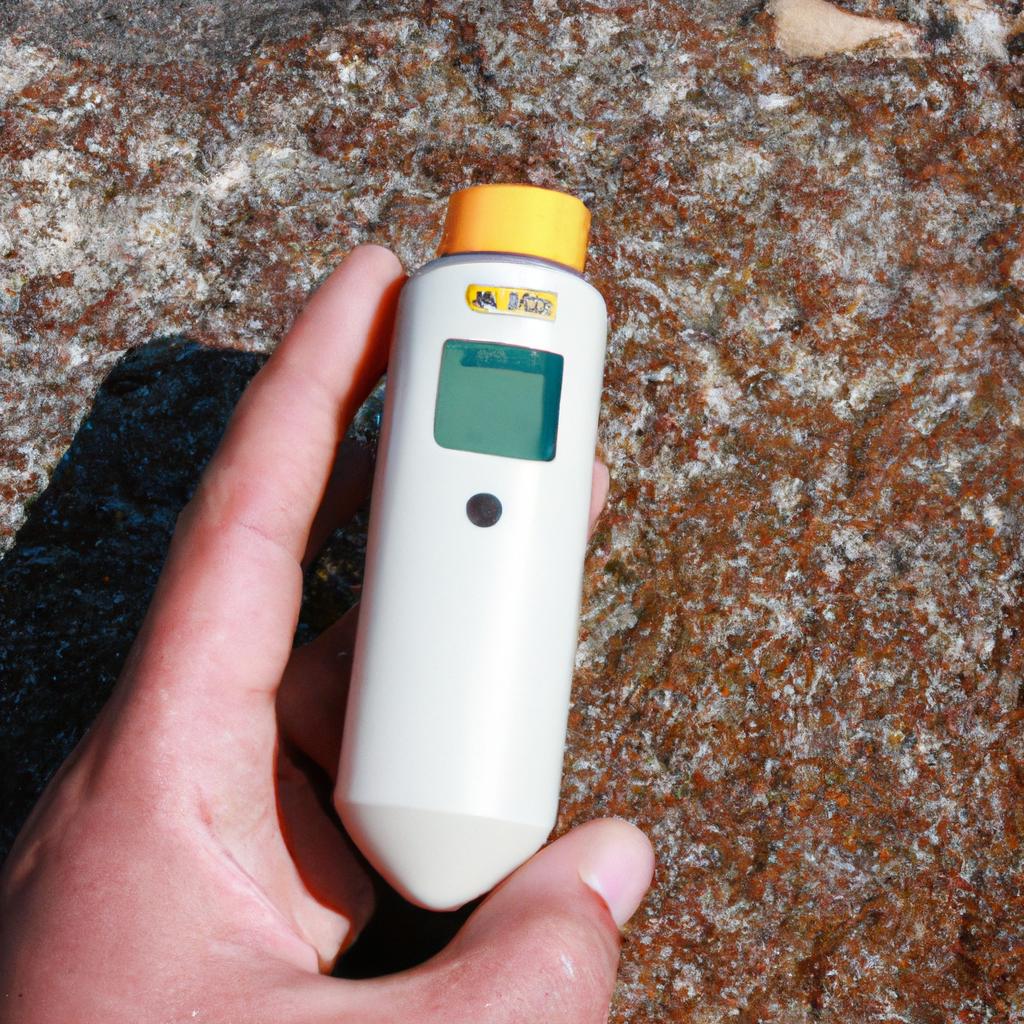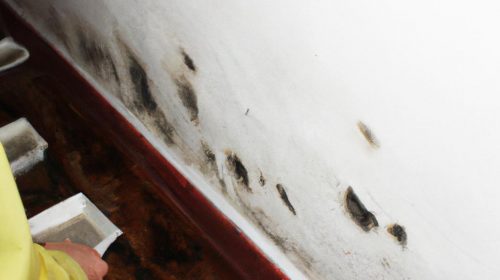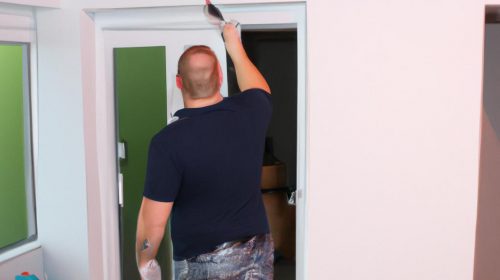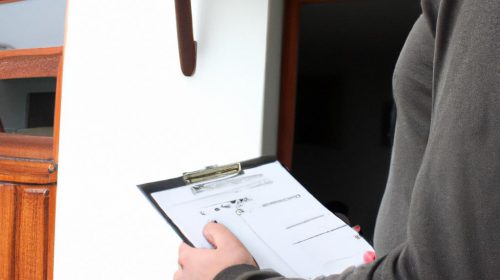Radon Testing in Real Estate: A Critical Component of Home Inspections
Radon, a colorless and odorless radioactive gas, is a significant environmental concern that can infiltrate homes through cracks in the foundation or gaps around pipes. Exposure to high levels of radon has been linked to an increased risk of lung cancer, making it imperative for homeowners and potential buyers to be aware of its presence within residential properties. This article aims to highlight the importance of radon testing as a critical component of home inspections in the real estate industry.
Consider the case of John and Jane, a young couple searching for their dream home. After months of extensive research and countless house visits, they finally found a charming bungalow nestled amidst picturesque surroundings. The property seemed perfect – spacious rooms flooded with natural light, a well-maintained garden, and alluring curb appeal. However, unbeknownst to them, lurking beneath this idyllic facade was an invisible threat: high levels of radon gas seeping into the living spaces from the soil below. If not addressed promptly, this silent danger could have dire consequences on their health and wellbeing. Hence, understanding the significance of incorporating radon testing as an integral part of home inspections becomes crucial in ensuring safe and healthy living environments for individuals venturing into real estate investments.
Understanding Radon: What Every Homebuyer Should Know
Imagine purchasing your dream home, only to discover that it poses a hidden danger to you and your family. This scenario is all too real for many homeowners who were unaware of the presence of radon gas in their homes. Radon, a colorless and odorless radioactive gas, is a natural byproduct of uranium decay in soil and rock formations beneath houses. It seeps into homes through cracks and openings in foundations, accumulating over time to potentially harmful levels.
To fully comprehend the importance of radon testing in real estate transactions, it is crucial to understand the potential health risks associated with this hazardous gas. Exposure to high levels of radon has been linked to an increased risk of developing lung cancer, especially among non-smokers. In fact, according to the Environmental Protection Agency (EPA), radon is the second leading cause of lung cancer after smoking. This alarming statistic highlights the need for prospective homebuyers to prioritize radon testing during their property inspections.
To further emphasize the significance of taking action against radon exposure, consider the following emotional bullet points:
- Protecting your loved ones: By conducting thorough radon testing before finalizing a real estate deal, you are ensuring that your family will be safe from potential harm.
- Peace of mind: Knowing that your new home’s indoor air quality meets safety standards can provide invaluable peace of mind for both you and your family.
- Long-term health effects: Addressing radon concerns early on can help mitigate long-term health consequences such as lung cancer and respiratory issues.
- Property value preservation: Taking measures against radon not only safeguards your well-being but also helps maintain property values by preventing future complications.
Moreover, let us examine a table outlining common sources and dangers associated with various levels of residential radon concentrations:
| Level (pCi/L) | Health Risk | Necessary Action |
|---|---|---|
| 2-4 | Minimal risk | Consider mitigation if level persists |
| 4-10 | Increased risk of lung cancer | Consult with professionals for mitigation |
| 10-20 | High risk of lung cancer; equivalent to smoking half a pack per day | Immediate action required |
| Above 20 | Severe health risks, comparable to heavy smoking | Urgent and thorough mitigation necessary |
Understanding the potential dangers associated with different radon levels underscores the importance of prioritizing radon testing during home inspections. By taking proactive measures, homeowners can protect their families from harmful exposure while preserving property values.
Transitioning into the subsequent section about “The Dangers of Radon Gas: Protecting Your Family’s Health,” it is crucial to explore the steps one should take after identifying high radon levels in a property.
The Dangers of Radon Gas: Protecting Your Family’s Health
Understanding Radon Testing: Ensuring a Safe Living Environment
Imagine purchasing your dream home, only to later discover that it harbors an invisible threat – radon gas. This scenario is not uncommon, as many homeowners are unaware of the potential dangers that radon can pose. To protect yourself and your family from this hazardous gas, it is crucial to include radon testing as a critical component of your home inspection process.
One example that highlights the importance of radon testing involves a young couple who recently purchased a charming house in a suburban neighborhood. Excited about their new beginning, they decided to conduct a thorough inspection before moving in. As part of the evaluation, radon testing was performed and revealed high levels of radon gas in the basement. Thanks to the early detection, they were able to implement mitigation measures promptly, ensuring a safe living environment for themselves and future occupants.
To emphasize the significance of radon testing, consider these key points:
- Radon is an odorless and colorless gas that occurs naturally in rocks and soils.
- Prolonged exposure to high levels of radon increases the risk of developing lung cancer.
- The Environmental Protection Agency (EPA) estimates that approximately 21,000 deaths each year in the United States are attributed to radon-related lung cancer.
- Mitigation systems installed after detecting elevated levels of radon can significantly reduce its concentration indoors.
| Key Facts | Impact on Health | Recommendation |
|---|---|---|
| Radon is radioactive | Increases risk of developing lung cancer | Test homes for radon regularly |
| Second leading cause | Responsible for around 10% lung cancers | Install mitigation systems if high levels detected |
| Can infiltrate any building | Long-term exposure poses higher risks | Educate others about dangers of radon |
Radon testing should be viewed as an essential step when purchasing a new home, as it allows for early detection and mitigation of this silent danger. By taking the necessary precautions, you can ensure that your living environment is safe and free from harmful radon gas.
Transitioning into the subsequent section about “Why Radon Testing Matters: Ensuring a Safe Living Environment,” it becomes evident that protecting oneself and loved ones from potential health risks should be a top priority. Understanding the significance of radon testing further underscores the importance of ensuring a safe place to call home.
Why Radon Testing Matters: Ensuring a Safe Living Environment
Understanding the potential health risks associated with radon gas is crucial. However, recognizing the importance of radon testing during real estate transactions takes this knowledge to another level. By conducting thorough radon tests as part of home inspections, homeowners can safeguard their families against unnecessary exposure and ensure they are making informed decisions about their living environment.
Section:
Imagine you have found your dream home—a charming bungalow nestled in a peaceful neighborhood. The house checks all the boxes on your wish list, and everything seems perfect until you stumble upon an alarming fact—your dream home could be concealing high levels of invisible danger known as radon gas. This realization highlights why radon testing plays such a critical role in real estate transactions.
To emphasize the significance of addressing radon concerns promptly, consider these key points:
- Radon is a radioactive gas that occurs naturally in soil and rock.
- It seeps into homes through cracks in foundations, floors, and walls.
- Long-term exposure to elevated levels of radon increases the risk of lung cancer, especially for non-smokers.
- Conducting proper radon testing ensures early detection and enables necessary mitigation measures.
Let us delve deeper into understanding the relevance of radon testing by examining its impact on both occupants’ health and property values:
| Impact on Health | Effect on Property Values | |
|---|---|---|
| High Levels | Increased risk of lung cancer; poses severe health hazards | Reduced demand; properties may take longer to sell |
| Low/Moderate Levels | Potential long-term health effects; should still be addressed for optimal safety | Minimal impact; awareness and mitigation efforts may improve value |
| No Radon | Peace of mind, knowing the living environment is safe | Positive influence on property values |
By recognizing the potential risks associated with radon gas and its direct correlation to health outcomes, homeowners can make informed decisions regarding necessary testing and mitigation measures. The next section will explore the process involved in radon testing, from detection to effective mitigation strategies.
Understanding why radon testing matters lays a strong foundation for comprehending how this crucial procedure ensures a safe living environment. By examining the various steps involved in detecting and mitigating radon gas levels, we gain insight into protecting our homes and loved ones effectively.
The Process of Radon Testing: From Detection to Mitigation
Radon testing is a crucial aspect of home inspections, ensuring the safety and well-being of individuals living in a property. By detecting this odorless and invisible gas, homeowners can take appropriate measures to mitigate its presence and create a healthier living environment. To fully understand the significance of radon testing in real estate, let us explore the process involved.
Consider the case of a hypothetical family purchasing their dream home. During the home inspection process, they decide to include radon testing as part of their due diligence. The results reveal elevated levels of radon in the basement, indicating potential health risks for future occupants. This discovery prompts them to negotiate with the seller for mitigation or financial compensation before finalizing the purchase agreement.
To better comprehend why radon testing matters, here are several key factors worth considering:
- Radon is responsible for approximately 21,000 lung cancer deaths each year in the United States alone.
- It is considered one of the leading causes of lung cancer among non-smokers.
- Long-term exposure to high levels of radon increases an individual’s risk of developing lung cancer significantly.
- Mitigating radon levels can reduce this risk and provide peace of mind for homeowners.
To emphasize these facts further, let us examine a table highlighting some statistics related to radon-induced lung cancer cases:
| Statistic | Percentage |
|---|---|
| Smokers | 10% |
| Non-Smokers | 5% |
| Over 20 pCi/L | Up to 50% |
| Under 4 pCi/L | Less than 1% |
As seen above, even low levels of radon pose certain risks that should not be overlooked. Consequently, it becomes imperative for prospective buyers or current homeowners to prioritize radon testing when evaluating residential properties.
In light of its impact on human health and safety, understanding how to interpret radon test results is vital. The next section will delve into this topic, providing valuable insights for homebuyers and homeowners alike. This knowledge empowers individuals to make informed decisions regarding radon mitigation and ensuring a safe living environment for themselves and their loved ones.
Radon Levels: Interpreting Test Results for Homebuyers
Transitioning smoothly from the previous section, let us now delve into the significance of interpreting radon test results for homebuyers. Understanding these results is crucial as it enables potential homeowners to make informed decisions about their purchase. To illustrate this point, consider a hypothetical scenario where two houses are being compared:
In House A, the radon test reveals levels below the recommended threshold set by regulatory authorities. This information provides assurance that occupants will be exposed to minimal health risks associated with radon gas.
On the other hand, House B’s test results indicate high radon levels exceeding the recommended limit. In such cases, prospective buyers can weigh the additional costs and time required for mitigation against their desire to reside in that particular property.
Interpreting these test results effectively requires familiarity with key factors and considerations. Here are some important points to keep in mind when interpreting radon test results:
- Duration of testing: Longer testing periods provide a more accurate representation of average radon levels.
- Location of testing: Tests should be conducted on all livable floors since different areas within a house may have varying concentrations of radon.
- Health implications: It is essential to understand the health risks associated with elevated radon levels and how they might affect occupants over an extended period.
- Potential remedies: Identifying viable options for remediation allows homebuyers to determine if they are willing to invest in mitigating measures or negotiate repairs before finalizing their purchase.
To further emphasize the importance of understanding radon test results, consider the following table showcasing potential health effects related to certain exposure levels:
| Exposure Level (pCi/L) | Health Effects |
|---|---|
| 2 | No significant increased risk |
| 4 | Increased lung cancer risk |
| 8 | Moderate lung cancer risk |
| 20 | High lung cancer risk |
This table serves as a stark reminder that even moderately elevated radon levels can pose potential health risks. Therefore, interpreting test results accurately is paramount for making informed decisions when purchasing a property.
In the subsequent section, we will explore the importance of working with professionals and choosing a certified radon testing service. By understanding the significance of engaging experts in this field, homebuyers can ensure reliable and accurate assessments of radon levels in their prospective homes without any personal bias or inaccuracies.
Working with Professionals: Choosing a Certified Radon Testing Service
Section 3. Working with Professionals: Choosing a Certified Radon Testing Service
Transitioning from the importance of interpreting radon test results, it is crucial for homebuyers to work with professionals who can accurately conduct and interpret these tests. By choosing a certified radon testing service, buyers can ensure that their potential homes are thoroughly inspected and any necessary mitigation measures are taken.
For instance, let us consider the case of Mr. and Mrs. Johnson, who recently purchased a new house without conducting a proper radon test. Unaware of the high levels present in their basement, they moved into the property only to discover health issues later on. This unfortunate scenario could have been avoided had they hired a certified radon testing service during the inspection process.
When selecting a radon testing service, there are several key factors to consider:
- Certification: Ensure that the company or individual performing the test holds relevant certifications such as National Radon Proficiency Program (NRPP) or National Radon Safety Board (NRSB). These certifications demonstrate expertise and adherence to industry standards.
- Experience: Look for providers with extensive experience in conducting radon tests specifically tailored to real estate transactions.
- Equipment Quality: Verify that the testing equipment used by the service provider is up-to-date and regularly calibrated to provide accurate readings.
- Comprehensive Reporting: Choose a service that provides detailed reports including information about test duration, location, specific measurement units employed, and interpretation guidelines.
To further emphasize the impact of working with certified professionals in this field, consider the following table illustrating different scenarios when dealing with uncertified versus certified testers:
| Scenario | Uncertified Tester | Certified Tester |
|---|---|---|
| Accuracy of Test Results | Inconsistent | Reliable and Accurate |
| Expertise in Radon Mitigation | Limited | Proficient and Knowledgeable |
| Understanding Local Regulations | Partial or Incomplete | Up-to-date and Compliant |
| Liability for Misinterpretation of Data | Ambiguous | Clearly Defined |
As we can see, choosing a certified radon testing service provides homebuyers with confidence in the accuracy of test results, expertise in mitigation strategies if required, knowledge of local regulations, and clear liability guidelines.
In conclusion, working with professionals who are certified in radon testing is essential to ensure a thorough inspection process during real estate transactions. By adhering to industry standards and employing reliable equipment, these experts offer accurate measurements, comprehensive reporting, and valuable guidance on mitigating potential radon risks. Homebuyers must prioritize selecting reputable providers to guarantee their safety within their new homes.



